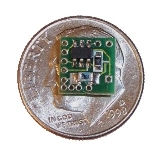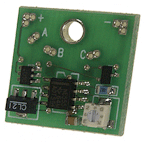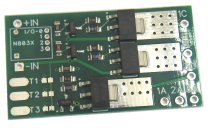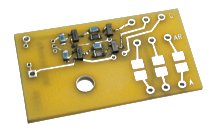Best viewed using:
Internet Explorer
or
Mozilla Firefox



Due to the wide variety of modeling scales, LEDs for use with these products are sold separately and can be found by clicking on the Lighting Products link at the left side of this page.
NEW LOW-VOLTAGE SIMULATORS SEE DETAILS BELOW
Two new LOW-VOLTAGE
Simulator families
have been introduced: The NLA803X series for analog (DC) operation,
and the NLD803X
for DCC Sound decoders with 3.3-volt accessory
functions and RC applications that use 3.7-3.8 volt batteries. These
low-voltage versions have a wide effective input voltage range of
3.2 to 16 (maximum) volts DC.
To select a Simulator best suited for your
scale and type of operation click on "Which
Sim is best for me?" in the More Info table to
the right of each product description below.
This simulator replicates the older-style signal and hazard warning flashers that used incandescent (filament) lamps to generate light. Typical flash rate of 3/4 second with a increasing and decreasing brightness curve to duplicate that of filament type lamps. Three outputs will each drive up to one pair (wired in series) of red and/or yellow LEDs Outputs flash sequentially so the module could also drive a very short series of "chase" lights.
This simulator provides a single repeating burst, increasing and decreasing in intensity for a single yellow 20ma LED. While designed to mimic a typical roof warning beacon, it also simulates the effect of most early-era bulb-type roadside warning flashers (detour, road work, pedestrian crossing, hospital zone, etc.).
| Item# | Cart | Price |
| N8032 | $12.95 | |
| NLA8032 | $13.95 | |
| N8032A | $12.95 | |
| NLA8032A | $13.95 |
| Item# | Cart | Price |
| N8110-15 |
$21.95 |
|
Variable-rate Alternating Flasher This module creates an alternating flash between a pair (or pairs) of LEDs with a 50% duty cycle (equal on and off times). Rate of flash is adjustable from 30 flashes per second (33 ms) to one flash every 3 seconds. This adjustment is made by rotating the slotted center of a variable resistor (bottom right corner of flasher). This product supports "common anode" devices, see More Info for details.
|
|
Variable-rate Flasher Produces a flash with a 50% duty cycle (equal on and off times). Rate of flash is adjustable from 30 flashes per second (33 ms) to one flash every 3 seconds. This adjustment is made by rotating the slotted center of a variable resistor (bottom right corner of flasher).
|
|
Emergency Flasher This module is designed to produce a short "burst" flash of approximately 1/15 of a second (65-70 ms) at a rate of two times per second (2 Hz). This simulates strobe flashers such as those used on modern-era road work signs..
|
|
Signal Flasher Produces a flash of 3/4 of a second (700-750 ms) with a 50% duty cycle (equal on and off periods). This simulates the style of flasher used for various modern-era traffic signals, certain highway/roadway conditions, air traffic clearance for buildings/radio towers, etc.
|
|
Alternating Flasher This module creates an alternating flash between a pair (or pairs) of LEDs of approximately 3/4 of a second and 50% duty cycle. This is a typical sequence for standard modern-day grade crossings. This product supports "common anode" devices, see More Info for details. This module is also included in a Crossing Signal Detection & Driver Board sold by Royz Trains. Go here: Royz Trains for more information.
|
|
At just 3/4" square, this product series includes a state-of-the-art current source which provides a constant 20 ma for LEDs connected to the module. This means any color 20 ma LED can be connected without the need for external current limiting resistors, multiple LEDs can be connected in series (requires a power source of sufficient voltage) and different colors of LEDs can be combined in the same series. All will operate at 20 ma. For certain applications it may be desirable to have the LED (or series string) connected to operate at less than full brightness. For this purpose, solder pads are included on the back of the module for placement of resistors to adjust of current source output. Input voltage range 6-16 VDC. Extra power wires included. Super Flashers  AUTOMATIC CURRENT PROTECTION! |
|
High-current Smoke Generator Controller & Timer The N8103B Smoke Generator Controller/Timer is essentially a very high current switching circuit combined with one of our N8050 single output Simulators programmed as a timing circuit. The timer is mounted on the Current Control main board. The heart of the Current control board is a N-Channel HEXFET Power MOSFET that can act as a power switch to easily control up to 16 Amps of 12-volts DC. Note: Actual power switched is based on power supply (not included) that is connected to the N8103B.
 |
|
As with the N8103 Booster Boards above, these Super Boosters come in 3 flavors: N8103A-1 to support a single output Simulator, N8103A-2 for 2 output Simulators, and N8103A-3 for 3-output Simulators. A Simulator is easily be piggybacked on a Booster Board (connecting wire included) and share a common power input for both. However, there are many modeling situations where a particular lighting effect may be desirable if it can be reproduced on many LEDs (series or parallel groups) or LEDs that exceed the 25mA or 5-volts DC. This is where our Booster Boards shine (forgive the pun). At just 0.8" x 1.50", these small boards increase a simulator's output up to times a Simulator's output and a DC voltage range of 9-18 VDC. This greatly expands the versatility of many of our Simulator products, especially where LEDs can be wired in series groups!
Our Simulator boards can also be programmed to perform as timer modules to
turn on and off outputs in timing ranges from seconds (or even
milli-seconds) to hours. When coupled with these Super Boosters a vary wide
range of control and automation can be performed.
Standard voltage operating range for the Super Booster Board is 6 to 18 volts DC. This voltage range is determined by the on-board voltage regulator mounted on our Simulator boards The Boosters come in 3 flavors: N8103-1 to support a single output Simulator (i.e., N8032 Beacon), N8103-2 for 2 output Simulators (i.e., N8038 Early-era Alternating Flasher), and N8103-3 for 3-output Simulators (i.e., N8043 Universal Strobe). A Simulator is easily be piggybacked on a Booster Board (connecting wire included) and share a common power input for both. This is the big brother of our Simulator Booster Boards. It is exactly the same size (0.8" x 1.50") as our N8103 product above, but has a much larger final-stage power transistor for the output. This allows a much wider range of control of many of our newer products like multiple sound modules or much larger groups of LEDs. It also allows driving much higher current LEDs for special lighting situations.
The tiny size of our Miniature Simulator modules above make them
extremely versatile for all modeling scales. However, this size also limits
output driving capability to 25mA at 5-volts DC per output channel. This is
sufficient to support a very wide range of lighting effects.
Super Boosters Simulator Boosters 
High current output boost plus added control solder points Supports up to 18VDC per output channel
 |





















